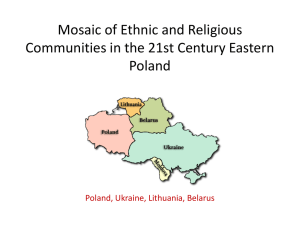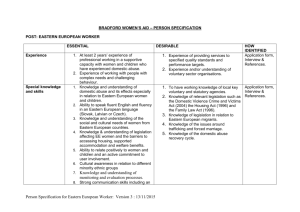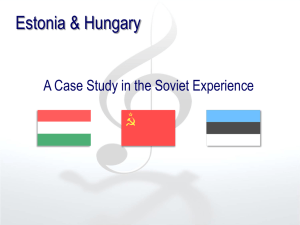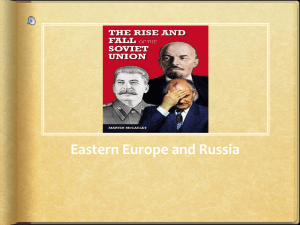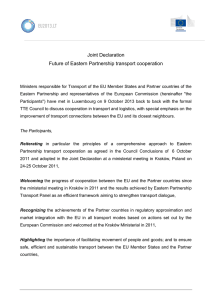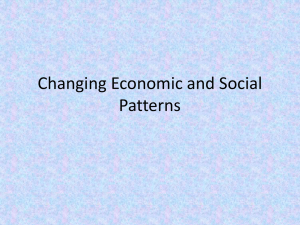Eastern European Studies: History Author: Tomasz Blusiewicz PhD
advertisement
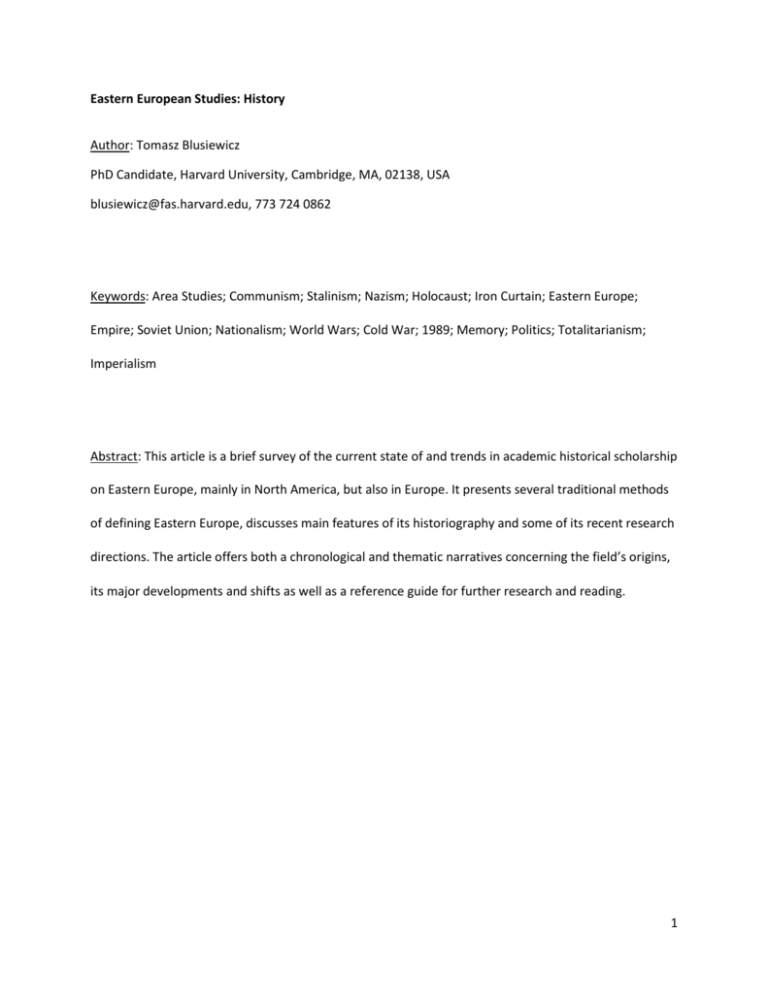
Eastern European Studies: History Author: Tomasz Blusiewicz PhD Candidate, Harvard University, Cambridge, MA, 02138, USA blusiewicz@fas.harvard.edu, 773 724 0862 Keywords: Area Studies; Communism; Stalinism; Nazism; Holocaust; Iron Curtain; Eastern Europe; Empire; Soviet Union; Nationalism; World Wars; Cold War; 1989; Memory; Politics; Totalitarianism; Imperialism Abstract: This article is a brief survey of the current state of and trends in academic historical scholarship on Eastern Europe, mainly in North America, but also in Europe. It presents several traditional methods of defining Eastern Europe, discusses main features of its historiography and some of its recent research directions. The article offers both a chronological and thematic narratives concerning the field’s origins, its major developments and shifts as well as a reference guide for further research and reading. 1 The field of Eastern European historical scholarship has undergone dramatic changes since the collapse of communist regimes in 1989. Eastern Europe as a distinct geopolitical region has never been more sharply delineated than between the late 1940s and 1989, when its primary reference was essentially synonymous with the non-Soviet, European part of the ‘Soviet Block’. In the West, ‘Eastern Europe’ as an intellectual concept had its origins in the Enlightenment vision of the world; it referred to a transitory space between the civilized ‘West’ and the exotic ‘Orient’ (Wolff, 1994). As a scholarly discipline it began to emerge only in the interwar period – it dealt with the newly-organized space that appeared on the map as a result of the fall of four empires: Austro-Hungarian, German, Ottoman and Russian. It was the Cold War and its geopolitical pressures, however, that led to the emergence of ‘Eastern European studies’ as an institution well-established in the academic world. Many historians of the region were émigrés and not infrequently - as they were collectively labeled in the West ‘dissidents’, who through their research, writing, teaching and government advising were involved in the process of ‘liberating’ Eastern Europe from the Soviet domination (Brzezinski, 1956; Pipes, 1976). Contributing to the Cold War confrontation was not the only preoccupation of historians of Eastern Europe, but nonetheless the field has been faced with a need to reinvent its basic framework after the dissolution of the Soviet Union in 1991. Many scholars, including the author of the previous article in this encyclopedia (Blackwood, 2001), predicted that such a redefinition would be extremely difficult and the field would eventually dissolve and/or integrate with the broader European narrative. This process is far from complete and while the field has been shifting in that direction, it still retains its specificity and can be approached as a separate unit. This article focuses on two related themes. First, it examines what criteria are used by historians to define what counts and what does not count as ‘Eastern European history’. Secondly, it surveys new work in the field, outlines how it is related to older historiography and how it communicates with new trends in historical scholarship. In conclusion, it offers several reflections on 2 what kind of light some of recent geopolitical shifts such as the EU enlargement (in the 2000s) and the Ukrainian crisis (2013-2014) shed on Eastern Europe as a concept and what they portend about its future. The chief difficulty facing historians who insist on the validity of Eastern Europe as a historical term is the lack of Eastern European identity among the peoples of the region. This obstacle is much less pronounced for nation-state (German, Polish, Hungarian, etc.) or imperial (British, Soviet, Habsburg, etc.) historians where the domain of study is much more clearly defined through subjective identities and/or political boundaries. Eastern Europeans rarely think of themselves as Eastern Europeans per se; all studies show that this identity is either non-existent or insignificant in comparison with national, religious or pan-European identities. In this sense, the field of Eastern European historical studies can be seen as ‘inorganic’ – its origins are rooted in global conditions largely beyond Eastern Europe’s control (imperial rivalries, World Wars, the Cold War, etc.). In other words, the field owes its existence largely thanks to an outsider ‘gaze’ cast upon the region. One of the most authoritative surveys of the region’s twentieth century history (Rothschild and Wingfield, 2007) is entitled Return to Diversity. The title unequivocally implies that the region has returned to its historical ‘norm’ (diversity) after half a century of ‘forced’ convergence in the Soviet Block. Eastern European ‘return to diversity’ is tied with one of the original lenses through which the region has been perceived – the allegory of a bridge between East and West, a place where cultures meet and give birth to numerous mixed formations. The validity of the ‘return to diversity’ thesis is implicitly confirmed by recent developments in political science and in the new sub-field of ‘transitology’ in particular; one of transitology’s chief aims is to explain the diverging trajectories of states that seemed so similar politically prior to 1989. Many scholars search for deeper historical causes such as early modern democratic experiences to account for this phenomenon. What are the main features 3 amidst this newly reconstituted diversity that form the common denominators large enough to validate speaking of a common regional history? Perhaps the oldest division line separating ‘Western’ and ‘Eastern’ Europe is of religious nature. Starting with the split of the Roman Empire into two halves, through Byzantine-Greek Christianization of much of the Balkans or the Kievan Rus, the Great Schism of 1054 or the Muscovite ‘Third Rome’ ambitions, the rift between Latin and Greek Europe has always been noticeable and usually deep. In 1983, the Hungarian historian Jenő Szűcs suggested that parts of what was then known as ‘Eastern Europe’ (Poland, Czechoslovakia, Hungary) were miscategorized. These areas have always been, he argued, a part of the ‘Western civilizational sphere’ since their adoption of Christianity from Rome and not from Constantinople. The Orthodox faith and administration, the Cyrillic alphabet or the absence/weakness of Protestant Reformation are thus posited as the original and decisive factors explaining the differences between the two parts of the continent. In Poland and Hungary, the image of these two countries being the ‘bulwarks of Christian faith’ containing the Orthodox and (more typically) Islamic element has become a part of national consciousness in the Early Modern period. In general, this basic distinction is rarely questioned, but there is little new scholarship that would operate within religiously defined frameworks, especially after the ‘atheistic’ communism cast aside what had been earlier perceived as a defining feature of Russianness – Orthodox religiosity. Another frequently drawn and almost as old a distinction is of economic character. The ‘Iron Curtain’ ultimately did not fall between the ports of Stettin and Trieste as Winston Churchill announced in 1946, but closer to the ports of Lübeck in Germany and Burgas in Bulgaria. This seemingly incidental detail of geography must have intrigued many historians. The border between West and East Germany eventually materialized very close to the Elbe River – one of the major fault lines drawn by economic historians. It separates the world of nascent commercialization of agriculture in Western and the second 4 wave of feudalism in Eastern early modern Europe. Naturally, the final course of the border between East and West Germany had nothing to do with economic history and a lot to do with where the Allied and Red Armies met in 1945. Still, the next four decades made the Elbe River divide, already bleak in 1945, plainly visible again. Eastern Europe, besides being popularly and somewhat stereotypically viewed as Western Europe’s poor relative, is understood by some economic historians to be a region where the second wave of feudalization and de-urbanization took place just when Western Europe began to urbanize and ready itself for the industrial revolution. Both the forced Soviet-style industrialization and the current EU-integration are sometimes framed as attempts to close this old gap. The initial advancements achieved by the Soviet Block economies between 1945 and mid-1970s have been interpreted by an historian of the region, Ivan Berend, as the region’s temporary ‘detour from periphery’, a detour brief in its promise since the region returned to its point of departure after the stagnation and collapse of the 1980s (Berend, 1996). Jenő Szűcs has also pointed to the spread of civil and municipal liberties in the late Middle Ages, exemplified, for instance, by urban settlement based on the German (Magdeburg) law as a factor with momentous political consequences for where the border between ‘Western’ and ‘Eastern’ Europe eventually crystallized in political terms. The substantial experience with (qualified) democracy, civil rights and the rule of law in, e.g., the early modern Habsburg Empire or the Polish-Lithuanian Commonwealth, were occasionally cited by cold war era historians as features distinguishing ‘democratic’ and ‘Central European’ parts of the Soviet Block from the ‘despotic’ territories traditionally administered from Moscow and Istanbul. In this context, the stable Czechoslovak democracy of the interwar period was frequently seen as evidence that this state was firmly in the ‘Western’ sphere while all the other ‘children of Versailles’, who eventually drifted toward various forms of authoritarianism, were truly in ‘Eastern Europe’ (Seton-Watson, 1945). This way of viewing Europe became more popular especially after the suppressed ‘pro-democratic’ unrest in Hungary, Czechoslovakia and Poland (1956, 5 1968, 1970, 1980) and after the ‘successful’ democratization in those countries and ‘problematic’ democratization in Belarus, Ukraine or Russia after 1989/91. Religious, economic or political are merely three among numerous other ‘macro’ lines according to which the map of Europe can be divided. As Larry Wolff points out, before Peter the Great’s introduction of Russia onto the European diplomatic scene, the division of Europe into ‘north and south of the Alps’ had been much more firmly embedded in the European mind. All lines of this type are of course arbitrary and depend on the kinds of questions asked and the historical period studied; no serious historian argues that one can define what Eastern Europe is and what its borders are precisely and conclusively. Nevertheless, the region’s entanglement with communism in the twentieth century is a part of its heritage of that cannot be overestimated. Judging by volume alone, the twentieth century communist experience, with all of its extensive and complex tropes, is currently the main subject of study for historians of the region. This experience is strongly intertwined with more pan-European topics such as totalitarianism, World Wars and superpower confrontation. If one adds the Holocaust, ethnic cleansing, forced population transfers and all other ‘terrible things that happened in the twentieth century’, what emerges is singlehandedly the most extensive subject of the region’s historical research and the cornerstone of its historical memory. Before surveying some of the major trends in historiography, it is worth mentioning that Eastern Europe borders with several well-established regions of historical scholarship: Russian/Soviet, Ottoman/Middle Eastern, German, Italian, Scandinavian, etc. The borders between them will never be rigid and the very impossibility of drawing even tentative lines in some areas lead to a new sub-field of scholarship which focuses precisely on these mixed, ambiguous and contradictory areas often called ‘borderlands’. This field is of course not limited to Eastern Europe, but some of its provinces such as Galicia (Frank-Johnson 2005), Transylvania (Case, 2009) and towns such as Lvov (Amar, 2008) or Salonica 6 (Mazower, 2006), due to their ethnic, religious or cultural diversity, have by now become recognized as exemplary cases demonstrating just how immensely complex and difficult to disentangle borderland territories can be. It has to be kept in mind, however, that what might be described as a ‘typical’ Eastern European borderland by an outsider might be considered to be an integral element of a core ethnic area by a local nationalist (Transylvania for some Hungarians or Romanians, Galicia for Poles and Ukrainians). While historians rarely argue about whether a given region or topic belongs to, for example, Eastern European or Russian studies, what did emerge as an important contender for Eastern European studies is the idea of Central Europe and the scholarly movement it inspired. This term has its roots in the imperial German concept of Mitteleuropa, but it reemerged in a different context half a century later. It was re-invented and re-fashioned by anti-communist dissidents such as Milan Kundera, Czesław Miłosz and Danilo Kiš. Kundera’s essay ‘The Tragedy of Central Europe’ (1984) is often perceived as the moment when the idea was reborn. In essence, the argument was that Central Europe (by which Czechoslovakia, Poland and Hungary were usually meant) has always belonged to Western Europe in civilizational terms, but has been ‘kidnapped’ and politically imprisoned in the Eastern European sphere by the Soviet power. While the political implications of this intellectual movement became largely irrelevant after 1989 and certainly after the EU extension in 2004 and 2007, a new wave of scholarship inspired by them emerged and found institutionalization in, e.g., the Central European History Journal. This new ‘Central European wave’ is located in an intermediate position between the old German and the dissident ideas; the late Austro-Hungarian Empire, with its cosmopolitan and culturally vibrant cities of Vienna, Prague, Budapest or Cracow, are painted as ‘archetypically’ Central European sites. Scholars who identify themselves as Central Europeanists come from various backgrounds; not infrequently they are historians of German-speaking lands who reach out to areas that had a rich record of contact with German culture and administration. While this field does not compete with Eastern 7 Europe in any direct sense, its position has been steadily ascending vis-à-vis its neighbor for several reasons. The late Habsburg Empire has enjoyed a remarkable reputational renaissance, largely because its many imperfections do not stand a comparison with all the tragic events that befell the region after the Empire disintegrated. The Empire has been portrayed as a kind of a proto-EU project where many ethnicities and languages coexisted relatively peacefully within one political unit for centuries (Oscar Jászi, 1929). Furthermore, fin-de-siècle Vienna or Prague with world-class artists and intellectuals such as Freud, Mahler, Wittgenstein or Kafka, are commonly seen as manifestations of European cultural vibrancy at its best (Schorske, 1979). But most importantly, the inhabitants of Prague or Cracow virtually universally prefer being spoken of as Central Europeans rather than Eastern Europeans. The success of the Central European University in Budapest shows that there is plenty of willingness to cooperate and produce knowledge under a common Central European banner. Central European scholars such as Pieter Judson or Rogers Brubaker have been at the forefront of the study nationalities and nationalism - a traditional Eastern European topic - and the late AustroHungarian Empire has been one of the main case studies used to address issues such as national identity formation, national cohesion and indifference, bilingualism or mixed families (Judson 2006, Brubaker 1996). Following Eugene Weber’s groundbreaking book Peasants into Frenchmen (1976), historians of the Austro-Hungarian Empire demonstrated how a nineteenth century region inhabited largely by villagers and small town folk with local (geographical, tribal, familial) or religious identities turned into region as we know it today - inhabited by Germans, Czechs, Slovaks or Croats (King, 2005). One of the leading questions still to be answered is ‘when (and why) nationalism began to hate’ – i.e. how an initially ‘progressive’ ideology of intellectuals intent on helping the ‘small peoples’ suffering under oppressive imperial government transformed itself into one of the main sources of conflict in twentieth century Europe (Porter, 2000). In this context, the transatlantic gaze of ‘outsiders’ and the multi-ethnic composition of the Austro-Hungarian Empire helped to avoid the trap into which many native nation8 state historians fell – writing biased national histories favoring one particular ethnicity and contributing to keeping the flame of nationalism alive. This type of approach to the study of nationalism has seen fruitful application to the Soviet area as well. Terry Martin’s Affirmative Action Empire (2001) demonstrates how illusory was the Soviet (and global) conviction that the so-called ‘nationalities question’ had been solved in the borderlands of the Soviet Union and why this issue came back with a vengeance in the late 1980s as the Union disintegrated along its ethnically defined internal borders. How the relationship between ‘Eastern’ and ‘Central’ European fields is going to evolve is impossible to predict; both are products of a unique set of circumstances and both are likely to find their place within a larger European or global framework. Immediately after 1989, the traditional Eastern European (and to some extent Soviet) field was supplied with new materials accessible at the local archives. The first wave of research focused on the early period (1945-1956) around the theme of communist takeover and Stalinization (Kenney 1997, Connelly 2000). The current consensus on the subject has been well summarized by Joseph Rothschild and Nancy Wingfield: “Today we recognize that many of the Western academic analyses of the 1950s and 1960s subscribed to exaggerated images of a rigid blueprint that supposedly guided Moscow and the local East Central European Communists in implementing the procedures and arrangement that Stalin eventually selected to give effect to his perception of Soviet hegemonial requirements. But while correcting this early presumptions, we should not throw out the baby with the bath water. For though there probably never was a rigid uniform Stalinist plan to be imposed in cookie-cutter fashion on every state and society of East Central Europe without regard to diverse national histories, institutions and complexities, the general overall similarities in Soviet and local Communist behavior throughout the area in the first decade after World War II strongly suggests a unified conceptual framework – more flexible at the beginning than toward the close of that 9 decade, never entirely absent yet also never absolutely rigid.” (Rothschild and Wingfield, 2007, 75-76) A lot had been known about Stalinist terror and crimes, but new evidence allowed scholars to present detailed findings and provide more accurate statistics (Naimark, 1995). Documenting and making sure the memory of various types of transgressions committed by the Soviet and puppet regimes does not disappear became the main preoccupation of many locally-based historians (Applebaum 2012, Kusnierz 2013); special national institutes (e.g. the Institute of National Remembrance in Poland) were established also with such an aim in mind. The same observations apply to issues such as Nazi occupation and the Holocaust, most of which had been if not explicitly suppressed, than not very thoroughly explored by historians under communism, especially the period between September 1939 and June 1941, when Hitler and Stalin were allies (Gross, 1988). Continuing the tradition exemplified by writers such as Czesław Miłosz (1953), intellectual historians maintained their interest in the strength of communism’s ‘Hegelian bite’– trying to understand why Marxism appealed to so many Eastern European (and not only) intellectuals and what was their relation with the regime and its ideology (Shore, 2006). One aspect of the Stalinist period in Eastern Europe (1945-53) in particular that could not have been explored earlier was the issue of forced population transfers and deportations. While historians in the West could argue to what extent these transfers were voluntary or not, historians in Eastern Europe had to accept the official party line that spoke of their voluntary nature. Czechoslovakia, Poland and East Germany were in an ambivalent position due to the way the Germans were deported (1945-1948) on the one hand and due to the ‘alliance’ of ‘brotherly nations’ that was now imposed on them by their Soviet supervisors on the other. Hence the spike in research on this topic after 1989 (Ther and Siljak, 2001). Overall, the findings shows that the scale and brutality of post-1945 deportations has been much greater than it had been suspected. The ironically disturbing conclusion is that it was eventually Joseph 10 Stalin who helped to bring the old nationalist fantasy of ethnically pure states to fruition while where no clear ethnic separation took place (e.g., Eastern Ukraine, Southern Slovakia) – tensions are still high today, not unlike in the interwar period. The semblance of uniformity within the Soviet Block did not mislead too many observers. Already in the 1950s, the term ‘national communism’ was coined to capture the developments in Yugoslavia and then it was aptly transferred to describe post-1956 Poland, Hungary and Ceaușescu’s Romania in particular (Verdery 1991). Not unlike the ‘varieties of capitalism’ literature in the West, experts on Eastern Europe were quick to discern the characteristics of each ‘national communist’ system. Hungary became known for its relatively open and prosperous economy, Poland for its mild censorship, East Germany for the secret police, Romania for its familial nepotism. After 1989, historians could start examining how much of ‘block’ there really was in the Soviet Block beyond prima facie political, military or economic ties and similarities; the more research is carried out, the less the appearances seem to correspond to the underlying reality. With the Cold War still in full swing in the 1980s, it was difficult for the scholars of the region to avoid a bipolar division of the field into anti- and pro-communist camps, often one could not escape being labeled either a ‘cold warrior’ or a revisionist with crypto-communist sympathies. This characterization is no longer valid. The revolutions of 1989 were immediately followed by a wave of scholarship that sought to understand why the system collapsed so quickly. The ‘history of the present’ written by Timothy Garton-Ash immediately after the events of 1989 (Garton-Ash, 1990) has addressed many puzzles and new equally insightful research soon followed (Maier, 1999). But after the initial astonishment subsided, scholars reversed the question and asked: what made the system survive for so long despite its seeming incompatibility with the region’s societies? Thus the earlier scholarship on the establishment of communist power (1945-48) was recently complimented by studies of the Brezhnev 11 era of zastoy (stagnation) and looked for deeper sources of the regime’s stability. Many younger historians study the patterns of consumption (both material and cultural) in communist societies and arrive at intriguing findings highlighting just how little was understood about how the system worked internally on an everyday basis (Mazurek, 2010). Various polls conducted after 1989 consistently show that there exists a large amount of nostalgia for the bygone days, which suggests that the regimes must have enjoyed some real support. Studies of the ‘gray economy’ demonstrate that reliance on official figures on the planned economy can be misleading as they capture merely one aspect of a more dynamic and complex economic reality. Already in the eighteen century, the image of Eastern Europe was often associated with backwardness. Poor sanitary conditions, underdeveloped infrastructure, general poverty and disorder were impressions often conveyed by eighteen century ‘Enlightened’ travelers. In German vocabulary, the term Polnische Wirtschaft became synonymous with a badly managed economy. But it was also, among others, Eastern European émigré scholars who were instrumental in developing a comparative method of developmental studies, sometimes given an overall heading of ‘modernization theory’. The acute awareness of their country’s industrial weakness was one of the factors that propelled the Soviet leadership, and Stalin in particular, to launch a program of rapid state-sponsored industrialization in the 1930s. This method of economic development has then been transplanted onto Eastern Europe, especially between 1948 and 1956. There has been an ongoing debate among historians to what extent the communist experience can be understood as a modernization process. There is no consensus, but certainly an agreement that any evaluation depends on the country - underdeveloped countries such as Bulgaria or Romania benefiting more, more developed, as Czechoslovakia, less - and the field of human endeavor (culture, gender relations, economic, politics, etc.) in question. Many historians do agree that the dramatic socioeconomic transformation of the 1950s and 1960s could be characterized as a breakthrough in areas such as public education, social security and welfare, gender equality, 12 urbanization, industrialization, etc. The debate continues whether the human cost of these transformations was acceptable while some historians reject the modernization framework altogether. Especially those influenced by postmodern critiques of the modernization paradigm, such as Maria Todorova (1997) or Kate Brown (2005), argue that it is in the often self-serving eye of the beholder that ideas of superior or inferior development originate and should be rejected as both uninformative at best and prejudiced at worst. Scathing critique of the Western ‘colonizing’ gaze on Eastern Europe has been voiced especially by Todorova, who also expressed well-taken criticism of the idea of Central Europe as a project meant to include some in the elite ‘European’ club at the exclusion of the others – in particular the Balkans. World War II is an important chapter in any region’s history, but it left a particularly heavy mark in Eastern Europe. In his recent book entitled Bloodlands, Timothy Snyder (2010) documents just how much the region squeezed between Russia and Germany suffered, not only during World War II, but also in the 1930s (Holodomor in the Ukraine, Stalinist Purges) and after the war. The region is located precisely at the fault line between the two most murderous regimes in history and this basic fact has to be comprehended by anyone who studies it. The role of Eastern Europe as a victim of forces beyond its control has been a recurrent motif in the region’s literature and historiography. According to Milan Kundera, the experiences of World Wars and imperial domination molded a unique national subjectivity in the region, a subjectivity constantly aware of its very existence being fragile, in danger and at the mercy of larger powers. Poland has been portrayed already by early nineteenth century romantic writers as a ‘Christ of the Nations’ redeeming the transgressions of other nations. The traces of this tradition has remained alive in popular historical consciousness. While Snyder and other scholars use different language and metaphors, their writings remain within the tradition of writing about the PolishLithuanian Commonwealth and its peoples from a victimized perspective – one of the definitive works on Polish history, written by the British historian Norman Davis, is entitled God’s Playground (1979). 13 The history of Ukraine in the twentieth century is often written from a similar perspective – as primarily a victim of two regimes, Soviet and Nazi. Karel Berkhoff in Harvest of Despair (2004) provides an in-depth narrative of how the experience of Nazi occupation looked for the ‘ordinary’ Ukrainian, what were its daily dangers and deprivations. Mark Mazower’s (2008) comprehensive survey, Hitler’s Empire, is the first comparative account of the Nazi occupation in the entirety of Europe. Mazower demonstrates that the term ‘occupation’ did not entail an even remotely similar set of experiences for ‘Western’ and ‘Eastern’ Europeans, with the General Government and the territories of today’s Ukraine and Belarus being the most brutalized and exploited of all. This victimization narrative has been recently challenged and problematized, however. Works of Jan Gross (2001), starting with Neighbors: The Destruction of the Jewish Community in Jedwabne - a depiction of how local Polish population organized the killing of several hundred of their Jewish neighbors in the summer of 1941 - have made it impossible to hold that local populations were merely passive bystanders. The categories of resistance and collaboration have been recently revised and nuanced by numerous authors and the topics of postwar popular justice, retribution and memory have seen collaborative efforts by the most renowned authors in the field (Deak et al, 2000). The intersection of Eastern European and Jewish histories has been a vibrant field of study in the last two decades. While the Holocaust and Jewish studies in general were largely a taboo subject in the first several decades following the war on both sides of the Iron Curtain, these topics have seen a great deal of attention (including some major controversies) recently. Ranging from micro-studies such as Hans Walser Smith’s (2002) work on the small German town of Konitz (now: Chojnice) before the Great War to broad surveys spanning several centuries (Slezkine, 2004), Jewish history and European history are finally put into dialogue with each other. Poland has seen a wave of historically informed cinematography on the issues of Polish role in Jewish extermination – signifying that it is no longer an avoided subject it had been for half a century. The process of coming to terms with historical memory 14 and issues of guilt and responsibility has been addressed by Charles Maier in his evocative essays (Maier, 1988) and many historians followed suit. Historians of Eastern Europe, although often preoccupied with some of the ‘traditional’ topics outlined in this article, have not remained unaffected by recent trends in historical scholarships. The field has seen innovative work in gender (Wingfield, 2006), urban (Thum, 2011) and everyday history (Healy, 2007). Historians have also paid attention to ‘subaltern’ groups often overlooked in ‘traditional’ political or international histories: children (Zahra, 2011) and underprivileged ethnic groups such as the Roma. The crimes committed against this particular minority has recently emerged as one of the main topics of scholarship, finally filling a gap in the literature (Levy, 2000). Environmental history has been on the rise as well (Dawson, 1996). Traditional areas such as imperial history have in consequence received less attention, but there have been some path-breaking work in this area as well (Plokhy, 2014). It is impossible to do justice to even a small fraction of new scholarship in this short article, but it is beyond doubt that Eastern Europe as a field remains at the cutting edge of historical scholarship and in stimulating dialogue with the rest of the discipline. The calls to integrate Eastern European history not only with continental, but also global, history, have not remained unanswered. Naturally, the global approach has been most useful for historians of empires. Both the Austro-Hungarian and the Russian Empires have witnessed a sustained effort to reconnect their history with global agenda such as slave trade, global commerce, colonial expansion or racial relations, issues which had been often marginalized earlier due to the urgency of military, diplomatic and national questions. Especially the younger generation is keen on showing how the region they study participated and influenced global movements such as the Renaissance, Enlightenment, birth of mass politics, origin and spread of technological advances, etc. This focus on 15 interconnectedness, exchange and mutual influence emerges as a dominant motive of the current doctoral works on the region. Tony Judt’s Postwar (2005) has arguably been one of the first attempts to put Western and Eastern European history back together into one integral whole. It took one of the greatest minds of the generation to achieve this monumental and (not very long ago) hardly thinkable task. In 1989, the Berlin Wall was a symbolic and all-too-tangible expression of deep rifts splitting the heart of the continent. The last quarter century has witnessed all kinds of integration and interchange of unparalleled scale and intensity. The rapidity of these processes has exceeded all expectations and poses a challenge for historians and for the ongoing European integration project. Writing history is now a truly global enterprise and old nation-state boundaries of historiographies, though still strong, are being diluted every year. The recent crisis in Ukraine (2013-2014) did show that some of the Cold War categories still remain valid and that the rift between ‘Western’ and ‘Eastern’ Europe is not yet fully leveled. At the same time, it is certain that the model of Eastern European studies as it was conceived in the Cold War era is a thing of the past. This model would not function well in the current political or cultural reality. Many actively resist the Eastern European label and the conditions for Eastern European ‘commonalities’ no longer exist – to mention just two major reasons. Traditional clichés do not work either. The old language of nationalism and xenophobia seems to win more votes in some ‘old’ democracies such as France than in the ‘perennially nationalistic’ Eastern Europe. The differences in political orientation of two countries often put into one category by historians – Poland and Hungary – were rarely greater than in 2014. On the other hand, the twentieth century and the last twenty five years are just a fraction of the region’s millennial history and historians tend to be able to resist ‘pressures of the present’ rather well. There is certainly enough of shared history in ‘Eastern Europe’ to keep the field alive and to what extent it will perturbed by recent ‘divergent’ developments remains to be seen. 16 See also: Area and International Studies: Development in Eastern Europe; Communism; Eastern European Studies: Culture; Eastern European Studies: Society; Nationalism, Sociology of; Socialist Societies: Anthropological Aspect References: Amar, Tarik. “Different but the Same or the Same but Different? Public Memory of the Second World War in PostSoviet Lviv,” Journal of Modern European History, vol.9 (2011), 3: 373-396 Applebaum, Anne. Iron Curtain : The Crushing of Eastern Europe, 1944-1956. New York: Doubleday, 2012. Berend, T. I. Central and Eastern Europe, 1944-1993 : Detour from the Periphery to the Periphery. Cambridge: Cambridge University Press, 1996. Berkhoff, Karel C. Harvest of Despair : Life and Death in Ukraine Under Nazi Rule. Cambridge: Belknap Press of Harvard University Press, 2004. Brown, Kate. A Biography of no Place : From Ethnic Borderland to Soviet Heartland. Cambridge: Harvard University Press, 2004. Brubaker, Rogers. Nationalism Reframed : Nationhood and the National Question in the New Europe. Cambridge: Cambridge University Press, 1996. Brzezinski, Zbigniew. The Permanent Purge : Politics in Soviet Totalitarianism. Cambridge: Harvard University Press, 1956. Case, Holly. Between States : The Transylvanian Question and the European Idea during World War II. Stanford: Stanford University Press, 2009. Connelly, John. Captive University : The Sovietization of East German, Czech, and Polish Higher Education, 19451956. Chapel Hill: University of North Carolina Press, 2000. Davies, Norman. God's Playground : A History of Poland in Two Volumes. Oxford: Clarendon Press, 1981. Dawson, Jane I. Eco-Nationalism : Anti-Nuclear Activism and National Identity in Russia, Lithuania, and Ukraine. Durham: Duke University Press, 1996. Deák, István, Jan Tomasz Gross, and Tony Judt. The Politics of Retribution in Europe : World War II and its Aftermath. Princeton: Princeton University Press, 2000. 17 Frank Johnson, Alison. Oil Empire : Visions of Prosperity in Austrian Galicia. Cambridge: Harvard University Press, 2005. Garton Ash, Timothy. The Magic Lantern : The Revolution of '89 Witnessed in Warsaw, Budapest, Berlin, and Prague. New York: Random House, 1990. Gross, Jan Tomasz. Neighbors : The Destruction of the Jewish Community in Jedwabne, Poland. Princeton: Princeton University Press, 2001. ———. Revolution from Abroad : The Soviet Conquest of Poland's Western Ukraine and Western Belorussia. Princeton: Princeton University Press, 1988. Healy, Maureen. Vienna and the Fall of the Habsburg Empire : Total War and Everyday Life in World War I. Cambridge: Cambridge University Press, 2004. Jászi, Oszkár. The Dissolution of the Habsburg Monarchy. Chicago: University of Chicago Press, 1929. Judson, Pieter M. Guardians of the Nation : Activists on the Language Frontiers of Imperial Austria. Cambridge: Harvard University Press, 2006. Judt, Tony. Postwar : A History of Europe since 1945. New York: Penguin Press, 2005. Kenney, Padraic. Rebuilding Poland : Workers and Communists, 1945-1950. Ithaca: Cornell University Press, 1997. King, Jeremy. Budweisers into Czechs and Germans : A Local History of Bohemian Politics, 1848-1948. Princeton: Princeton University Press, 2002. Kusnierz, Robert. W Swiecie Stalinowskich Zbrodni : Ukraina w Latach Czystek i Terroru (1934-1938) w Obserwacjach i Analizach MSZ Oraz Wywiadu Wojskowego Drugiej Rzeczypospolitej. Słupsk: Wydawnictwo Naukowe Akademii Pomorskiej, 2013. Lewy, Guenter. The Nazi Persecution of the Gypsies. Oxford: Oxford University Press, 2000. Maier, Charles S. Dissolution : The Crisis of Communism and the End of East Germany. Princeton: Princeton University Press, 1997. ———. The Unmasterable Past : History, Holocaust, and German National Identity. Cambridge: Harvard University Press, 1988. Martin, Terry. The Affirmative Action Empire : Nations and Nationalism in the Soviet Union, 1923-1939. Ithaca: Cornell University Press, 2001. Mazower, Mark. Hitler's Empire : How the Nazis Ruled Europe. New York: Penguin Press, 2008. ———. Salonica, City of Ghosts : Christians, Muslims and Jews, 1430-1950. New York: Alfred A. Knopf, 2005. Mazurek, Małgorzata. Antropologia Niedoboru w NRD i PRL : 1971-1989. Wroclaw: ATUT, 2010. Miłosz, Czeslaw. The Captive Mind. New York: Knopf, 1953. 18 Naimark, Norman M. The Russians in Germany : A History of the Soviet Zone of Occupation, 1945-1949. Cambridge: Belknap Press of Harvard University Press, 1995. Pipes, Richard. The Formation of the Soviet Union, Communism and Nationalism, 1917-1923. Cambridge: Harvard University Press, 1954. Plokhy, Serhii. The Last Empire : The Final Days of the Soviet Union. New York: Basic Books, 2014. Porter, Brian. When Nationalism Began to Hate : Imagining Modern Politics in Nineteenth Century Poland. New York: Oxford University Press, 2000. Rothschild, Joseph and Nancy Wingfield. Return to Diversity : A Political History of East Central Europe since World War II. Oxford: Oxford University Press, 2008. Schorske, Carl E. Fin-De-Siècle Vienna : Politics and Culture. New York: Knopf, 1979. Seton-Watson, Hugh. Eastern Europe between the Wars, 1918-1941. Cambridge: Cambridge University Press, 1945. Shore, Marci. Caviar and Ashes : A Warsaw Generation's Life and Death in Marxism, 1918-1968. New Haven: Yale University Press, 2006. Slezkine, Yuri. The Jewish Century. Princeton: Princeton University Press, 2004. Smith, Helmut Walser. The Butcher's Tale : Murder and Anti-Semitism in a German Town. New York: W.W. Norton, 2002. Snyder, Timothy. Bloodlands : Europe between Hitler and Stalin. New York: Basic Books, 2010. Szűcs, Jenő. “Three Historical Regions of Europe”, Acta Historica Academiae Scientiarum Hungaricae, T. 29, No. 2/4 (1983), pp. 131-184 Ther, Philipp and Ana Siljak. Redrawing Nations : Ethnic Cleansing in East-Central Europe, 1944-1948. Lanham: Rowman & Littlefield, 2001. Thum, Gregor. Uprooted : How Breslau Became Wroclaw during the Century of Expulsions. Princeton: Princeton University Press, 2011. Todorova, Mariia Nikolaeva. Imagining the Balkans. New York: Oxford University Press, 1997. Verdery, Katherine. National Ideology Under Socialism : Identity and Cultural Politics in Ceauşescu's Romania. Berkeley: University of California Press, 1991. Weber, Eugen Joseph. Peasants into Frenchmen : The Modernization of Rural France, 1870-1914. Stanford: Stanford University Press, 1976. Wingfield, Nancy, eds. Gender and War in Twentieth-Century Eastern Europe. Bloomington: Indiana University Press, 2006. Wolff, Larry. The Idea of Galicia : History and Fantasy in Habsburg Political Culture. Stanford: Stanford University Press, 2010. 19 ———. Inventing Eastern Europe : The Map of Civilization on the Mind of the Enlightenment. Stanford: Stanford University Press, 1994. Zahra, Tara. The Lost Children : Reconstructing Europe's Families After World War II. Cambridge: Harvard University Press, 2011. Bucur, Maria Bucur and Nancy Wingfield, Gender & War in Twentieth-Century Eastern Europe. 2006. 20


